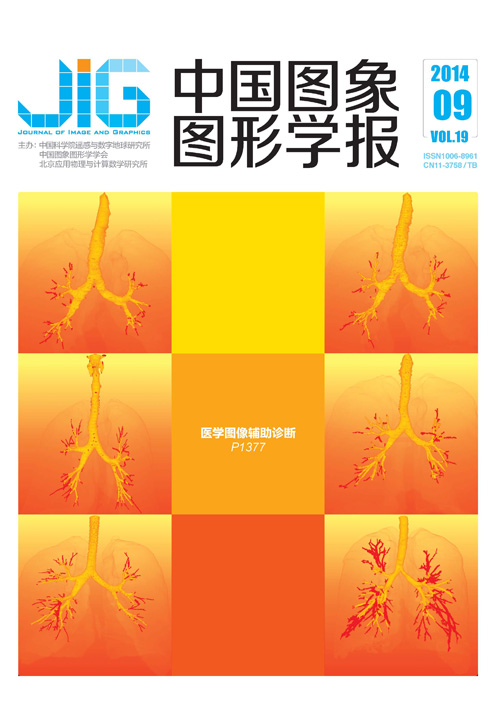
Dempster-Shafer证据融合金字塔韦伯局部特征的表情识别
王晓华1, 金超1, 任福继1,2, 胡敏1(1.合肥工业大学计算机与信息学院 情感计算与先进智能机器安徽省重点实验室, 合肥 230009;2.德岛大学 先端技术科学教育部, 日本 德岛 7708502) 摘 要
目的 针对韦伯局部特征(WLD)在局部细节表征上的局限性,提出一种基于金字塔韦伯局部特征(PWLD)的人脸表情识别方法。方法 首先对人脸图像进行预处理,分割出表情显著区域;然后根据显著区域大小进行分层并加以分块,对每一层的不同块提取PWLD特征,将测试集与训练集的PWLD直方图的卡方距离归一化作为独立证据来构造基本概率分配(BPA);最后利用D-S(Dempster-Shafer)证据理论联合规则得到融合后的BPA,进而得出识别结果。结果 在JAFFE库与Cohn-Kanade库上进行交叉验证,平均识别率分别为95.81%和97.47%。结论 PWLD特征在局部细节表征上比WLD特征更具有优势。与目前典型的方法进行对比实验,验证该方法的有效性和容错性,同时证明该方法在噪声和光照条件下具有一定的鲁棒性。
关键词
Research on facial expression recognition based on pyramid Weber local descriptor and the Dempster-Shafer theory of evidence
Wang Xiaohua1, Jin Chao1, Ren Fuji1,2, Hu Min1(1.School of Computer and Information of Hefei University of Technology, Anhui Province Key Laboratory of Affective Computing and Advanced Intelligent Machine, Hefei 230009, China;2.University of Tokushima, Graduate School of Advanced Technology & Science, Tokushima 7708502, Japan) Abstract
Objective Feature extraction is the most critical step in pattern recognition, and facial expression recognition is no exception.Weber Local Descriptor (WLD) is a Method that can effectively extract texture information from images and has the advantages of being consistent with human perception of human beings and being insensitive to noise and non-monotonic illumination variations. However, WLD has some limitations in the feature representation of local details. To overcome these limitations, a facial expression recognition Method based on Pyramid WLD (PWLD) is proposed in this study.Method First, facial images are preprocessed. This step includes the detection of faces from facial expression databases and normalization. The salient regions of segment 2 that have significant contributions to facial expression recognition from images are also preprocessed. One of these salient regions is that which includes the eyes and eye brows, while another is that with the mouth. The sizes of salient regions differ, and these regions contain different information. Thus, we stratify these salient regions and divide each layer into different blocks. The PWLD features of each block in each layer are then extracted and cascaded to represent the global and local features of a salient region reasonably, with some parameter adjustments. Second, we compute for the Chi-square distance of the PWLD histograms in both the testing and training sets. We then choose the minimum distance in every category of expressionsand normalize this distance to construct the Basic Probability Assignment (BPA) as independent evidence. To create the BPA, we use curve fitting in numerical analysis by simulating several sets of data. Finally, fusion BPA is obtained by using the Dempster-Shafer rule, and the Results are further obtained by employing thedecision-making and judgment of Dempster-Shafertheory of evidence.Result By fusing the PWLD features of the two different salient regions with Dempster-Shafer theory of evidence, we can overcome the limitations of a single regional featureand acquire more reliable and accurate Results. We conduct some cross-validation experiments on the JAFFE and Cohn-Kanade facialexpression databases, and the average recognition rates reach up to 95.81% and 97.47%, respectively. In addition, we perform some experiments with other algorithms, such as LBP, LDP, and Gabor; we also conduct some comparative experiments that combine the PWLD with different classifiers, such as 1-NN and SVM.Conclusion The WLD, which is known as a robust image descriptor, can well extract the texture information of images. Moreover, the PWLD can accurately describe the local details, which have more advantages than the WLD features. The comparative Results of some typical Methodsverify the effectiveness and fault tolerance of the proposed Method. The proposed Method has certain robustness under simultaneous noise and light conditions.
Keywords
facial expression recognition Weber local descriptor (WLD) pyramid Weber local descriptor (PWLD) Dempster-Shafer(D-S) theory of evidence
|



 中国图象图形学报 │ 京ICP备05080539号-4 │ 本系统由
中国图象图形学报 │ 京ICP备05080539号-4 │ 本系统由